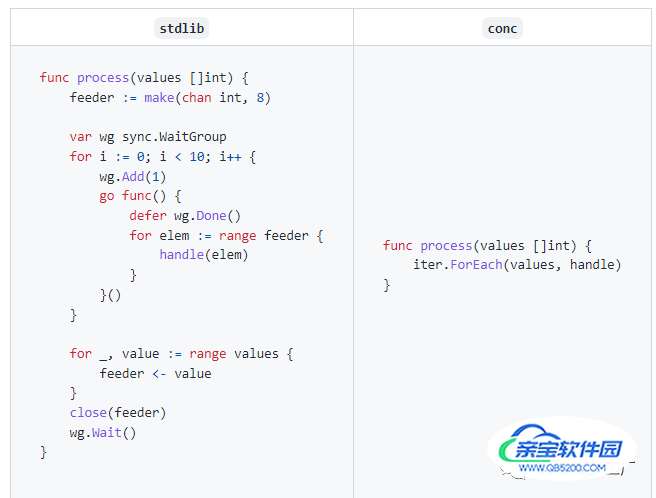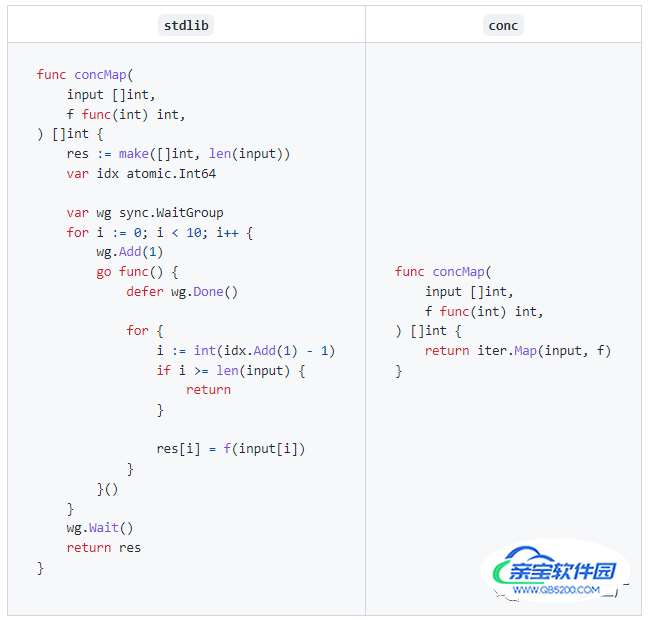一文带你了解Go语言实现的并发神库conc
asong2020 人气:0前言
哈喽,大家好,我是asong;前几天逛github发现了一个有趣的并发库-conc,其目标是:
- 更难出现goroutine泄漏
- 处理panic更友好
- 并发代码可读性高
从简介上看主要封装功能如下:
- 对
waitGroup进行封装,避免了产生大量重复代码,并且也封装recover,安全性更高 - 提供
panics.Catcher封装recover逻辑,统一捕获panic,打印调用栈一些信息 - 提供一个并发执行任务的
worker池,可以控制并发度、goroutine可以进行复用,支持函数签名,同时提供了stream方法来保证结果有序 - 提供
ForEach、map方法优雅的处理切片
接下来就区分模块来介绍一下这个库;
仓库地址:https://github.com/sourcegraph/conc
Go语言标准库有提供sync.waitGroup控制等待goroutine,我们一般会写出如下代码:
func main(){
var wg sync.WaitGroup
for i:=0; i < 10; i++{
wg.Add(1)
go func() {
defer wg.Done()
defer func() {
// recover panic
err := recover()
if err != nil {
fmt.Println(err)
}
}
// do something
handle()
}
}
wg.Wait()
}上述代码我们需要些一堆重复代码,并且需要单独在每一个func中处理recover逻辑,所以conc库对其进行了封装,代码简化如下:
func main() {
wg := conc.NewWaitGroup()
for i := 0; i < 10; i++ {
wg.Go(doSomething)
}
wg.Wait()
}
func doSomething() {
fmt.Println("test")
}conc库封装也比较简单,结构如下:
type WaitGroup struct {
wg sync.WaitGroup
pc panics.Catcher
}其自己实现了Catcher类型对recover逻辑进行了封装,封装思路如下:
type Catcher struct {
recovered atomic.Pointer[RecoveredPanic]
}recovered是原子指针类型,RecoveredPanic是捕获的recover封装,封装了堆栈等信息:
type RecoveredPanic struct {
// The original value of the panic.
Value any
// The caller list as returned by runtime.Callers when the panic was
// recovered. Can be used to produce a more detailed stack information with
// runtime.CallersFrames.
Callers []uintptr
// The formatted stacktrace from the goroutine where the panic was recovered.
// Easier to use than Callers.
Stack []byte
}提供了Try方法执行方法,只会记录第一个panic的goroutine信息:
func (p *Catcher) Try(f func()) {
defer p.tryRecover()
f()
}
func (p *Catcher) tryRecover() {
if val := recover(); val != nil {
rp := NewRecoveredPanic(1, val)
// 只会记录第一个panic的goroutine信息
p.recovered.CompareAndSwap(nil, &rp)
}
}提供了Repanic()方法用来重放捕获的panic:
func (p *Catcher) Repanic() {
if val := p.Recovered(); val != nil {
panic(val)
}
}
func (p *Catcher) Recovered() *RecoveredPanic {
return p.recovered.Load()
}waitGroup对此也分别提供了Wait()、WaitAndRecover()方法:
func (h *WaitGroup) Wait() {
h.wg.Wait()
// Propagate a panic if we caught one from a child goroutine.
h.pc.Repanic()
}
func (h *WaitGroup) WaitAndRecover() *panics.RecoveredPanic {
h.wg.Wait()
// Return a recovered panic if we caught one from a child goroutine.
return h.pc.Recovered()
}wait方法只要有一个goroutine发生panic就会向上抛出panic,比较简单粗暴;
waitAndRecover方法只有有一个goroutine发生panic就会返回第一个recover的goroutine信息;
总结:conc库对waitGrouop的封装总体是比较不错的,可以减少重复的代码;
worker池
conc提供了几种类型的worker池:
- ContextPool:可以传递context的pool,若有goroutine发生错误可以cancel其他goroutine
- ErrorPool:通过参数可以控制只收集第一个error还是所有error
- ResultContextPool:若有goroutine发生错误会cancel其他goroutine并且收集错误
- RestultPool:收集work池中每个任务的执行结果,并不能保证顺序,保证顺序需要使用stream或者iter.map;
我们来看一个简单的例子:
import "github.com/sourcegraph/conc/pool"
func ExampleContextPool_WithCancelOnError() {
p := pool.New().
WithMaxGoroutines(4).
WithContext(context.Background()).
WithCancelOnError()
for i := 0; i < 3; i++ {
i := i
p.Go(func(ctx context.Context) error {
if i == 2 {
return errors.New("I will cancel all other tasks!")
}
<-ctx.Done()
return nil
})
}
err := p.Wait()
fmt.Println(err)
// Output:
// I will cancel all other tasks!
}在创建pool时有如下方法可以调用:
p.WithMaxGoroutines()配置pool中goroutine的最大数量p.WithErrors:配置pool中的task是否返回errorp.WithContext(ctx):配置pool中运行的task当遇到第一个error要取消p.WithFirstError:配置pool中的task只返回第一个errorp.WithCollectErrored:配置pool的task收集所有error
pool的基础结构如下:
type Pool struct {
handle conc.WaitGroup
limiter limiter
tasks chan func()
initOnce sync.Once
}limiter是控制器,用chan来控制goroutine的数量:
type limiter chan struct{}
func (l limiter) limit() int {
return cap(l)
}
func (l limiter) release() {
if l != nil {
<-l
}
}pool的核心逻辑也比较简单,如果没有设置limiter,那么就看有没有空闲的worker,否则就创建一个新的worker,然后投递任务进去;
如果设置了limiter,达到了limiter worker数量上限,就把任务投递给空闲的worker,没有空闲就阻塞等着;
func (p *Pool) Go(f func()) {
p.init()
if p.limiter == nil {
// 没有限制
select {
case p.tasks <- f:
// A goroutine was available to handle the task.
default:
// No goroutine was available to handle the task.
// Spawn a new one and send it the task.
p.handle.Go(p.worker)
p.tasks <- f
}
} else {
select {
case p.limiter <- struct{}{}:
// If we are below our limit, spawn a new worker rather
// than waiting for one to become available.
p.handle.Go(p.worker)
// We know there is at least one worker running, so wait
// for it to become available. This ensures we never spawn
// more workers than the number of tasks.
p.tasks <- f
case p.tasks <- f:
// A worker is available and has accepted the task.
return
}
}
}这里work使用的是一个无缓冲的channel,这种复用方式很巧妙,如果goroutine执行很快避免创建过多的goroutine;
使用pool处理任务不能保证有序性,conc库又提供了Stream方法,返回结果可以保持顺序;
Stream
Steam的实现也是依赖于pool,在此基础上做了封装保证结果的顺序性,先看一个例子:
func ExampleStream() {
times := []int{20, 52, 16, 45, 4, 80}
stream := stream2.New()
for _, millis := range times {
dur := time.Duration(millis) * time.Millisecond
stream.Go(func() stream2.Callback {
time.Sleep(dur)
// This will print in the order the tasks were submitted
return func() { fmt.Println(dur) }
})
}
stream.Wait()
// Output:
// 20ms
// 52ms
// 16ms
// 45ms
// 4ms
// 80ms
}stream的结构如下:
type Stream struct {
pool pool.Pool
callbackerHandle conc.WaitGroup
queue chan callbackCh
initOnce sync.Once
}queue是一个channel类型,callbackCh也是channel类型 - chan func():
type callbackCh chan func()
在提交goroutine时按照顺序生成callbackCh传递结果:
func (s *Stream) Go(f Task) {
s.init()
// Get a channel from the cache.
ch := getCh()
// Queue the channel for the callbacker.
s.queue <- ch
// Submit the task for execution.
s.pool.Go(func() {
defer func() {
// In the case of a panic from f, we don't want the callbacker to
// starve waiting for a callback from this channel, so give it an
// empty callback.
if r := recover(); r != nil {
ch <- func() {}
panic(r)
}
}()
// Run the task, sending its callback down this task's channel.
callback := f()
ch <- callback
})
}
var callbackChPool = sync.Pool{
New: func() any {
return make(callbackCh, 1)
},
}
func getCh() callbackCh {
return callbackChPool.Get().(callbackCh)
}
func putCh(ch callbackCh) {
callbackChPool.Put(ch)
}ForEach和map
ForEach
conc库提供了ForEach方法可以优雅的并发处理切片,看一下官方的例子:

conc库使用泛型进行了封装,我们只需要关注handle代码即可,避免冗余代码,我们自己动手写一个例子:
func main() {
input := []int{1, 2, 3, 4}
iterator := iter.Iterator[int]{
MaxGoroutines: len(input) / 2,
}
iterator.ForEach(input, func(v *int) {
if *v%2 != 0 {
*v = -1
}
})
fmt.Println(input)
}ForEach内部实现为Iterator结构及核心逻辑如下:
type Iterator[T any] struct {
MaxGoroutines int
}
func (iter Iterator[T]) ForEachIdx(input []T, f func(int, *T)) {
if iter.MaxGoroutines == 0 {
// iter is a value receiver and is hence safe to mutate
iter.MaxGoroutines = defaultMaxGoroutines()
}
numInput := len(input)
if iter.MaxGoroutines > numInput {
// No more concurrent tasks than the number of input items.
iter.MaxGoroutines = numInput
}
var idx atomic.Int64
// 通过atomic控制仅创建一个闭包
task := func() {
i := int(idx.Add(1) - 1)
for ; i < numInput; i = int(idx.Add(1) - 1) {
f(i, &input[i])
}
}
var wg conc.WaitGroup
for i := 0; i < iter.MaxGoroutines; i++ {
wg.Go(task)
}
wg.Wait()
}可以设置并发的goroutine数量,默认取的是GOMAXPROCS ,也可以自定义传参;
并发执行这块设计的很巧妙,仅创建了一个闭包,通过atomic控制idx,避免频繁触发GC;
map
conc库提供的map方法可以得到对切片中元素结果,官方例子:

使用map可以提高代码的可读性,并且减少了冗余代码,自己写个例子:
func main() {
input := []int{1, 2, 3, 4}
mapper := iter.Mapper[int, bool]{
MaxGoroutines: len(input) / 2,
}
results := mapper.Map(input, func(v *int) bool { return *v%2 == 0 })
fmt.Println(results)
// Output:
// [false true false true]
}map的实现也依赖于Iterator,也是调用的ForEachIdx方法,区别于ForEach是记录处理结果;
总结
花了小半天时间看了一下这个库,很多设计点值得我们学习,总结一下我学习到的知识点:
- conc.WatiGroup对Sync.WaitGroup进行了封装,对Add、Done、Recover进行了封装,提高了可读性,避免了冗余代码
- ForEach、Map方法可以更优雅的并发处理切片,代码简洁易读,在实现上Iterator中的并发处理使用atomic来控制只创建一个闭包,避免了GC性能问题
- pool是一个并发的协程队列,可以控制协程的数量,实现上也很巧妙,使用一个无缓冲的channel作为worker,如果goroutine执行速度快,避免了创建多个goroutine
- stream是一个保证顺序的并发协程队列,实现上也很巧妙,使用sync.Pool在提交goroutine时控制顺序,值得我们学习;
加载全部内容